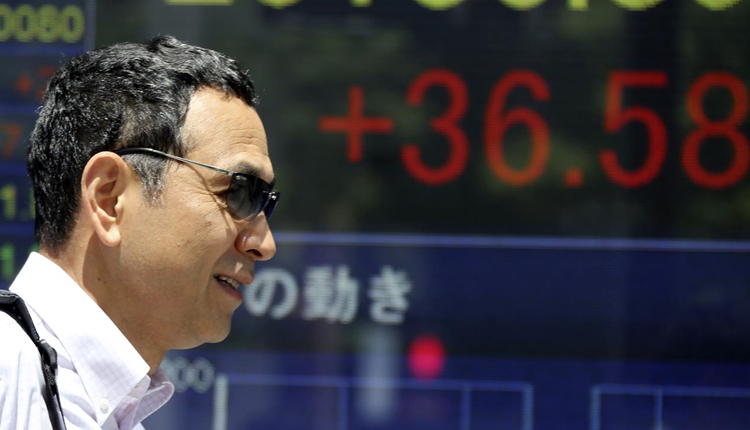Asian markets traded down Wednesday morning after an overnight plunge on Wall Street as investors worried about a potential economic slowdown and the state of the U.S.-China trade war.
The mainland Chinese markets, closely watched in relation to Beijing’s ongoing dispute with Washington, remained cautious by the end of the morning session. The Shanghai composite declined 0.21 percent while the Shenzhen composite was largely flat.
The Caixin Services Purchasing Managers’ Index, which measures economic activity in China’s services sector, rose to 53.8 in November— its highest in five months— as compared to 50.8 in October.
Earlier in the day, China’s Ministry of Commerce said in a statement on its website that the weekend meeting between Trump and Chinese President Xi Jinping was successful. The ministry also said the two countries will push ahead with negotiations within 90 days, and Beijing will work to address issues agreed upon as quickly as possible.
Meanwhile, the Hang Seng index in Hong Kong also fell by 1.54 percent. Shares of vehicle maker Baic Motor dropped 9.29 percent following a Bloomberg report that Germany’s Daimler is considering increasing its stake in its joint venture with the Chinese firm.
Rest of Asia mostly see losses
Elsewhere in Asia, Japan’s Nikkei 225 slipped 0.73 percent in afternoon trade while the Topix shed 0.69 percent. The losses were also seen in South Korea, where the Kospi declined by 0.57 percent.
In Australia, the ASX 200 fell 0.94 percent in afternoon trade, with most sectors trading lower. The moves came after the country’s gross domestic product (GDP) data for the third quarter came in below expectations.
Real GDP expanded 0.3 percent on-quarter in the three months through September and 2.8 percent on-year, according to data released by the Australian Bureau of Statistics on Wednesday.
Economists polled by Reuters had expected 0.6 percent growth on quarter and a 3.3 percent on-year increase.
Following the release of the data, the Australian dollar fell 0.65 percent to trade at $0.7289. It had earlier seen a high of $0.7355.
Banks in Asia slip
Banking and financial stocks in the region sold off, taking cues from the U.S.
Japan’s Mitsubishi UFJ Financial Group fell 1.41 percent while Nomura declined by 3.28 percent. In Hong Kong, HSBC fell 2.06 percent while China Construction Bank shed 1.62 percent.
Australia’s financial subindex was down 1.52 percent as shares of the so-called Big Four banks declined: Australia and New Zealand Banking Group shed 0.95 percent, Commonwealth Bank of Australia declined 1.33 percent, Westpac traded down 1.35 percent while National Australia Bank lost 1.11 percent.
Wall Street takes a dive
Stocks sold off overnight on Wall Street as the Dow Jones Industrial Average dropped 799.36 points, or 3.1 percent, to close at 25,027.07 — its worst day since Oct. 10.
The S&P 500 shed 3.2 percent to close at 2,700.06 while the Nasdaq Composite fell 3.8 percent to end the trading day back in correction territory at 7,158.43. Trading volume in U.S. stocks was also higher than usual on Wall Street.
The yield on the three-year Treasury note surpassed its five-year counterpart on Monday. When a so-called yield curve inversion happens — short-term yields trading above longer-term rates — a recession could follow, though it is often years away after the signal triggers.
Stocks began falling to their lows of the day after Jeffrey Gundlach, CEO of Doubleline Capital, told Reuters this inversion signals that the economy “is poised to weaken.”
The CBOE Volatility Index, popularly known as the VIX, leaped about 26.16 percent to 20.74. The VIX measures implied volatility on S&P 500 index options. It had earlier hit a high of 21.94 — its highest levels since Nov. 23 when it touched a high of 22.65.
Confusion over US-China trade agreement
Beyond concerns over the inversion in the yield curve, uncertainty surrounding the details of the agreement struck between U.S. President Donald Trump and Chinese President Xi Jinping in Buenos Aires weighed on investor sentiment.
The two economic powerhouses have been locked in an ongoing trade war, which has continued to rock global markets for much of 2018.
The U.S. and China agreed over the weekend to hold off on any additional tariffs on each other’s goods on Jan. 1, so that trade talks can continue.
But discrepancies over when that truce would begin has led to confusion, with conflicting messages coming from within the White House as well as differing opinions from Trump, Washington and Beijing over the actual details of the agreement.
“After the meeting, it was clear that there is no comprehensive deal but just a truce and that both sides are putting out somewhat different statements,” Dariusz Kowalczyk, senior emerging market strategist at Credit Agricole CIB, told CNBC’s “Street Signs” on Wednesday.
“The markets shouldn’t be surprised by the fact that there is some discrepancy between what both sides are perceiving as to what was agreed,” he said.
Currencies
The U.S. dollar index, which tracks the greenback against a basket of its peers, was at 97.087 after seeing an earlier low of 96.992.
The Japanese yen, widely viewed as a safe-haven currency, traded at 112.97 against the dollar after strengthening from above 113.5 yesterday.
Source: CNBC



